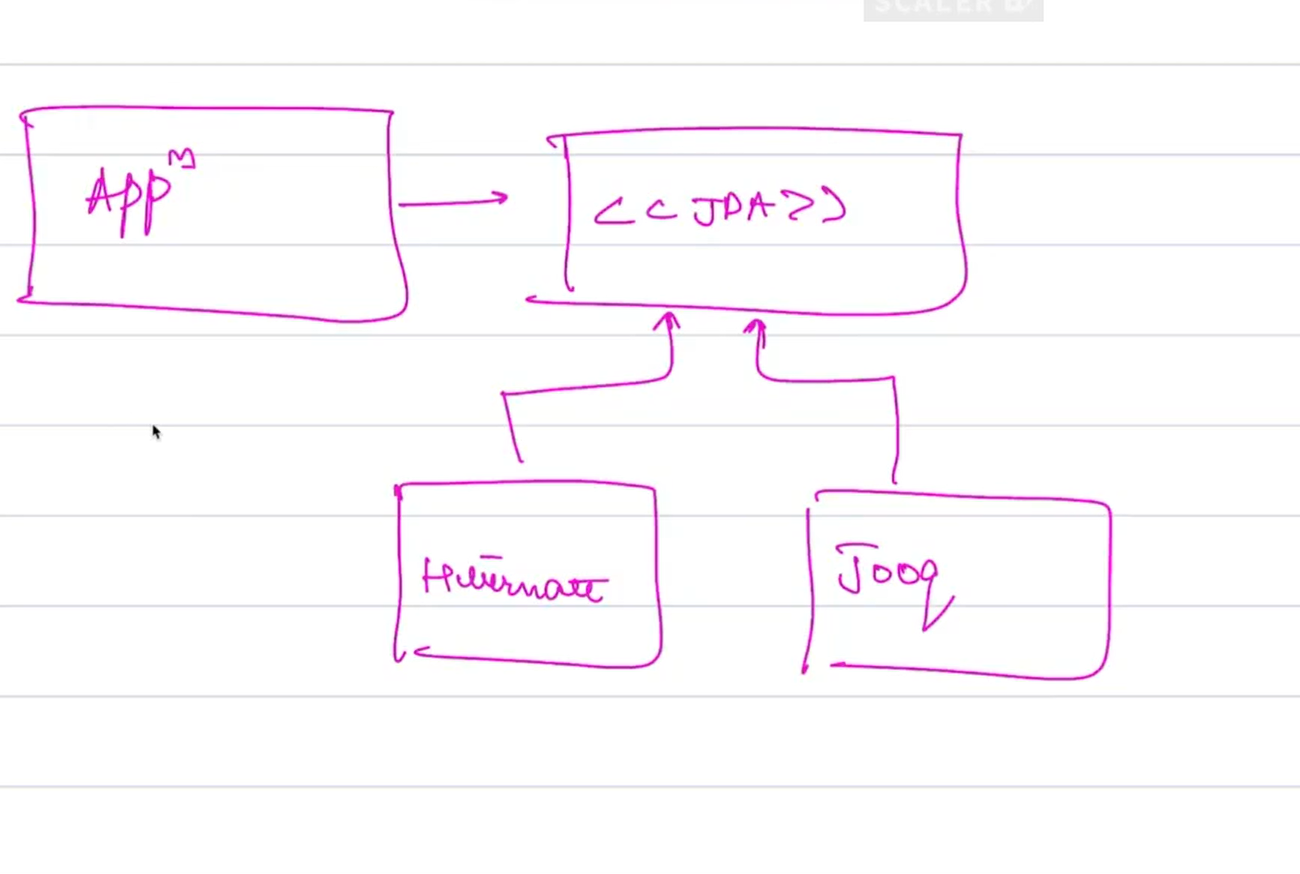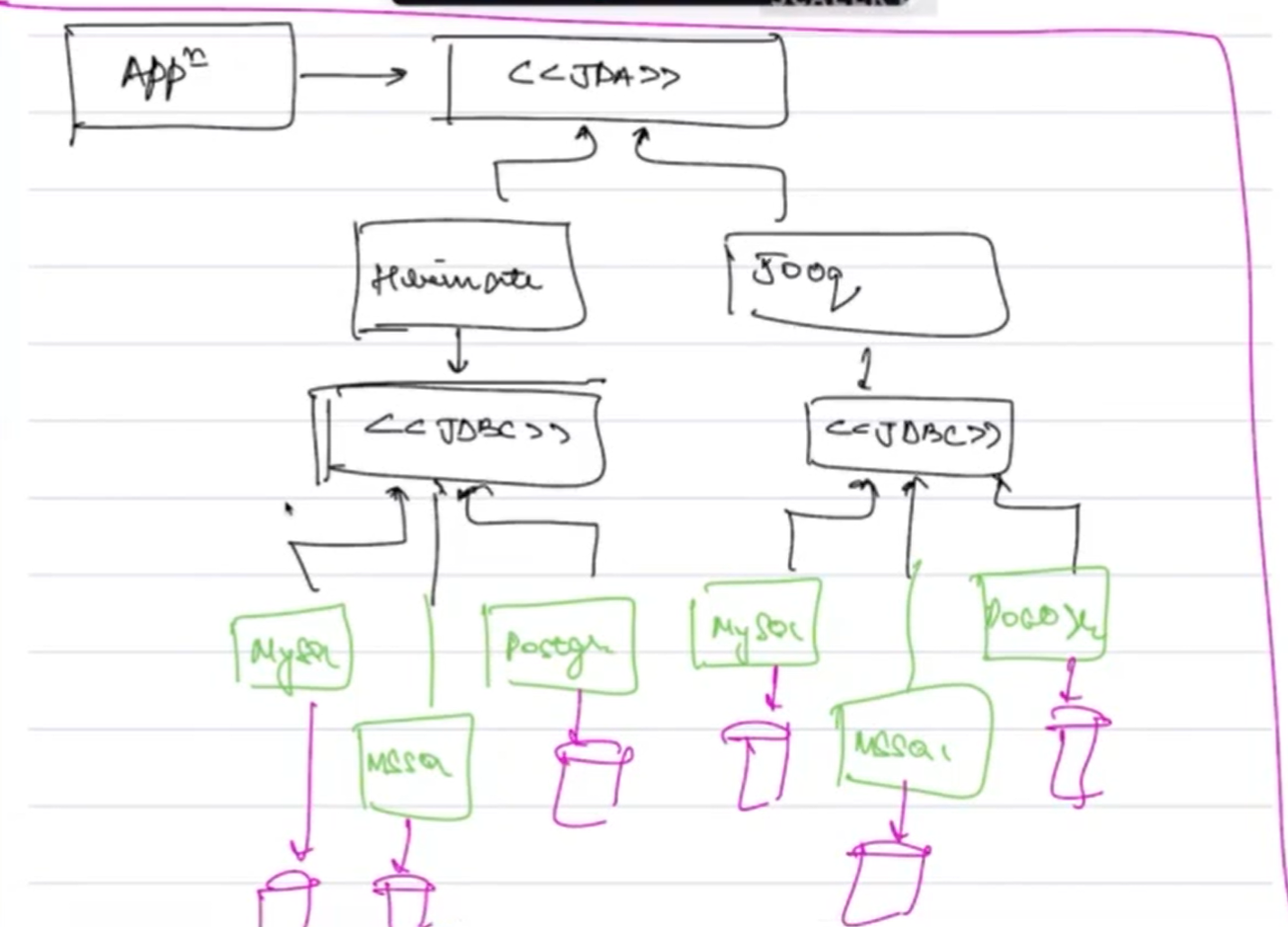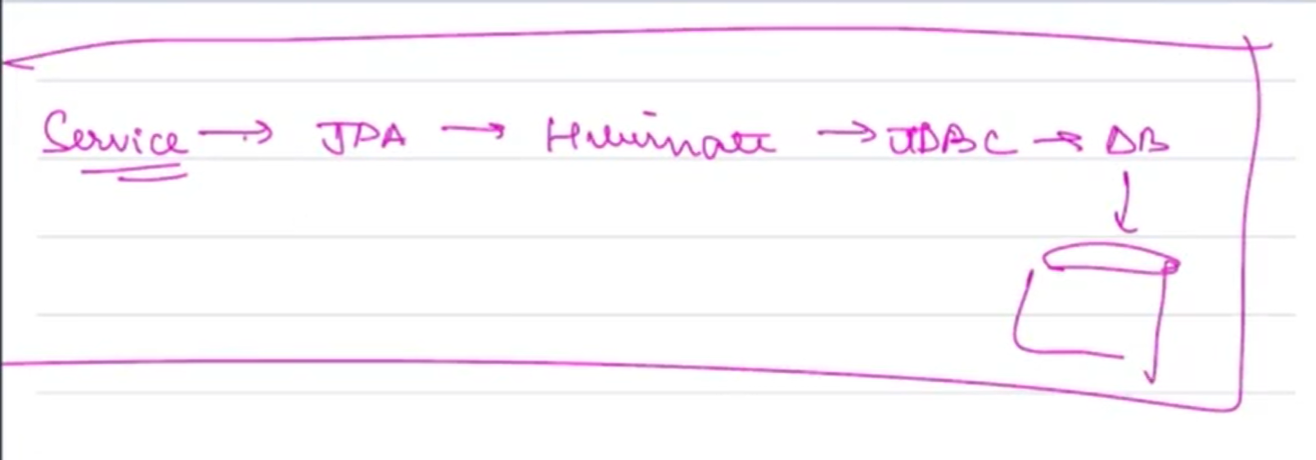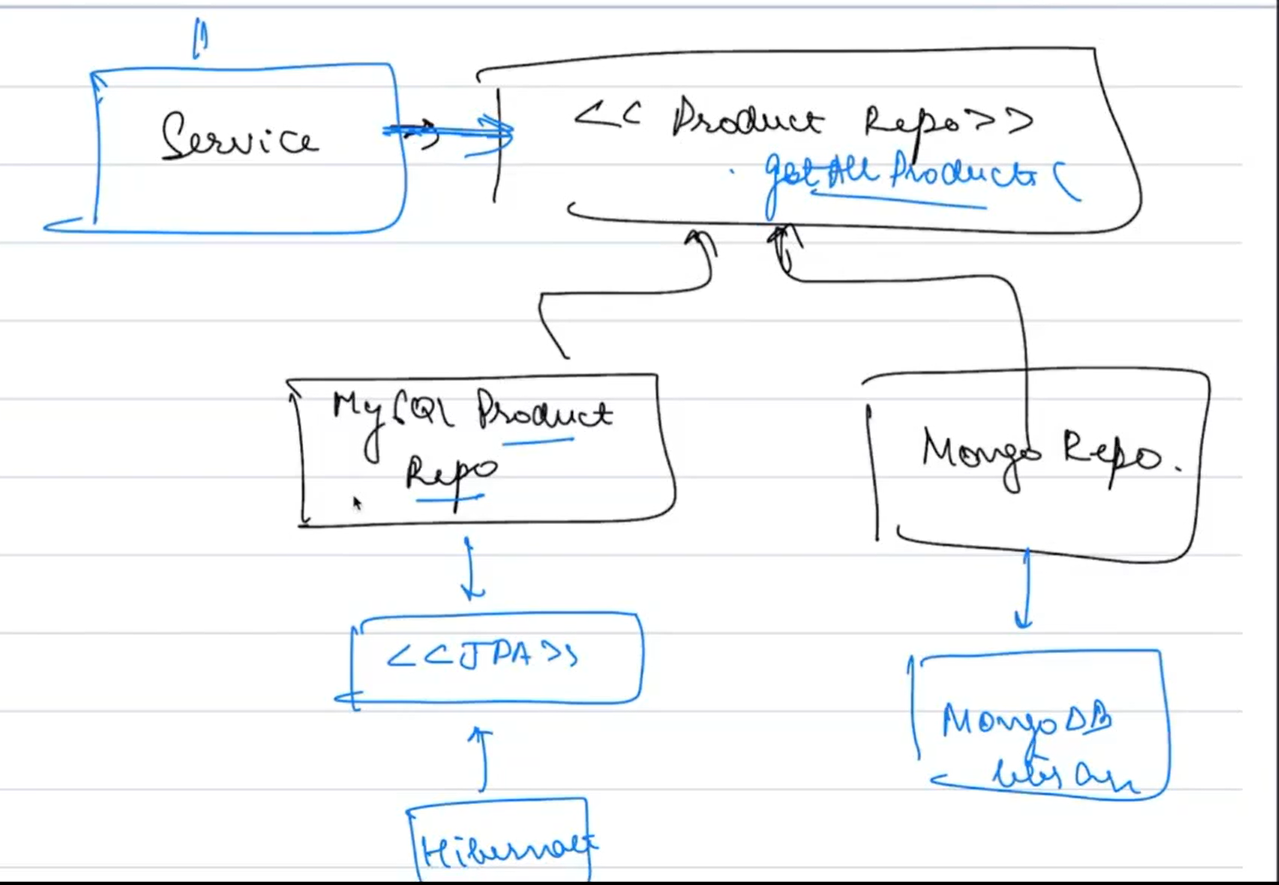Spring Data JPA, ORM, Hibernate, JDBC, and the Repository Pattern
Topics to be Covered:¶
- Introduction to Spring Data JPA
- The role of Object-Relational Mapping (ORM)
- Understanding Java Persistence API (JPA)
- Introduction to Hibernate, a popular ORM tool
- The significance of JDBC (Java Database Connectivity)
- Repository Pattern
- Separation of concerns between business logic and database interaction
- Advantages of using the repository pattern for scalable and maintainable code
Introduction to Spring Data JPA¶
Understanding Spring Data JPA¶
Spring Data JPA is an integral part of the Spring framework, providing an abstraction over the persistence layer, allowing developers to interact with databases in a more object-oriented manner. This abstraction is crucial for simplifying database operations and making the codebase more maintainable.
-
Transition from API Proxy to Database-Driven Applications:
- Up until this point, much of the code written might have acted as a proxy to existing APIs. These APIs are often external services that developers integrate into their applications.
- However, in real-world applications, the database is not merely an external component but rather a core element that directly influences the performance, scalability, and robustness of the application.
-
The Role of Databases in Applications:
-
A database is where all critical data of the application is stored, managed, and retrieved. For any application to function effectively, it must be capable of handling fundamental database operations such as:
- Creating Tables: Structuring data in a relational format, where data is organized into tables consisting of rows and columns.
- CRUD Operations: Performing Create, Read, Update, and Delete operations is essential for data management within the database.
-
Example Scenario:
- Consider an e-commerce application where you need to add a new product. The process would involve:
- Connecting to the Database: Establishing a connection to the database, which is often done through a DataSource or a connection pool.
- Executing SQL Queries: Writing and executing SQL queries to insert the product details into the database.
- Mapping Data: The product details, which are objects in your application (e.g.,
Productclass), need to be mapped to a corresponding database table (e.g.,productstable).
- Consider an e-commerce application where you need to add a new product. The process would involve:
-
Strong Correlation Between Code and Database:
- The classes and models defined in your codebase have a direct correlation with the tables in your database. For instance, each class in your code may represent a table, and each object instance corresponds to a row in that table.
- However, managing these correlations manually through SQL queries and database management code can be cumbersome and error-prone. This is where ORM comes into play.
-
Object-Relational Mapping (ORM)¶
What is ORM?¶
Object-Relational Mapping (ORM) is a programming technique used to convert data between incompatible systems, specifically between object-oriented programming languages and relational databases.
-
ORM Libraries: These libraries provide a framework to automatically map objects in your code to corresponding database tables. This mapping allows developers to interact with the database using the same objects and methods they use in their application code, rather than having to write raw SQL queries.
-
Core Concept:
-
When you define a model (e.g.,
Product.java), ORM libraries like Hibernate automatically handle the creation of a corresponding table in the database. This table will store all instances of theProductclass as rows, with each field of the class corresponding to a column in the table. -
Example:
- Class Definition: You define a class
Product.javawith attributes such asid,title,description, andcategory_id. - Database Mapping: The ORM library will create a
productstable with columns corresponding to the attributes of theProductclass. - Category Class: Similarly, a
Category.javaclass with attributesidandnamewill lead to the creation of acategorytable.

- Class Definition: You define a class
-
Simplified Database Interaction:
- With ORM, developers no longer need to write extensive SQL queries to perform database operations. Instead, they can work with objects in their code, and the ORM library translates these operations into the necessary SQL commands.
- For instance, fetching all products can be done through a simple method call:
List<Product> products = orm.getAllProducts();. The ORM handles the underlying SQL query, fetches the data, and returns it as a list ofProductobjects.
-
-
Advantages of ORM:
- Ease of Use: Developers can focus on writing business logic without worrying about the intricacies of database management.
- Consistency: Ensures that the data structure in the application is always consistent with the database schema.
- Query Abstraction: Queries can be executed as method calls, making the code cleaner and easier to understand.
-
Popular ORM Libraries:
- Hibernate: The most widely used ORM framework in Java, known for its robustness and flexibility.
- MyBatis and JOOQ: Other ORM alternatives that offer different levels of abstraction and customization.
-
Abstraction via JPA Interface:
- While using an ORM like Hibernate, it's important to code against an interface rather than a concrete implementation to maintain flexibility. In Java, this interface is known as the Java Persistence API (JPA).
- By coding against JPA, you can easily switch between different ORM implementations without modifying your business logic.

- Interface Principle: The principle of "Code to an interface, not an implementation" is crucial for maintaining a modular and scalable codebase. By adhering to this principle, your application remains adaptable to changes, such as switching the underlying database or ORM framework.
Deep Dive into Hibernate¶
Hibernate is an ORM library that simplifies database interactions in Java applications. It abstracts the complexity of database access by allowing developers to work with objects rather than SQL queries.
-
Database-Agnostic Design:
- Hibernate is designed to be database-agnostic, meaning it can interact with various types of databases like MySQL, OracleDB, and PostgreSQL without requiring changes to your application code.
-
JDBC (Java Database Connectivity):
- To communicate with different databases, Hibernate relies on the JDBC interface. JDBC is a low-level API that allows Java applications to interact with databases using SQL.
- JDBC serves as an intermediary between Hibernate and the database, ensuring that Hibernate can work with any database that provides a JDBC driver.

- Flow of a Query:
- When an application issues a database query through Hibernate, the following steps occur:
- Application: A method call is made, such as
orm.getAllProducts();. - Hibernate (ORM): Hibernate translates this method call into an appropriate SQL query.
- JDBC Interface: The SQL query is passed through the JDBC interface to the database.
- Database: The database executes the query and returns the result to Hibernate.
- Hibernate (ORM): Hibernate converts the result into objects and returns them to the application.
- Application: A method call is made, such as
- When an application issues a database query through Hibernate, the following steps occur:

- Flexibility: By using JDBC, Hibernate can interact with any database that implements the JDBC specification, making it highly flexible and adaptable.
Repository Pattern¶
Understanding the Repository Pattern¶
The Repository Pattern is a design pattern that promotes the separation of concerns by decoupling the business logic from the data access logic in an application. This separation enhances the maintainability and testability of the codebase.
-
Separation of Concerns:
- In an application, the Service Layer contains the core business logic that defines how data is processed and what operations are performed. This layer should not be concerned with how the data is retrieved from or stored in the database.
- The Data Access Layer (Repository Layer), on the other hand, is responsible for interacting with the database. It contains the logic for retrieving, storing, updating, and deleting data.
-
Loose Coupling:
- By separating the business logic from the data access logic, the repository pattern ensures loose coupling between these two layers. This means that changes in the database structure or the data access methods do not affect the business logic, and vice versa.
- Service Classes: These classes define what data is needed and how it should be processed.
-
Repository Classes: These classes define where the data is located and how to retrieve or store it.
-
Example Workflow:
- Service Class: Suppose you have a
ProductServiceclass responsible for managing product-related operations. - Repository Class: The
ProductRepositoryclass handles all database interactions for product data. - Interaction: When the
ProductServiceneeds to retrieve products from the database, it does not directly execute SQL queries. Instead, itcalls methods on theProductRepository, which abstracts the database operations.
- Service Class: Suppose you have a

- Advantages:
- Maintainability: The separation of concerns makes it easier to maintain the code, as changes in one layer do not impact the other.
- Scalability: The codebase can easily scale as the application grows, with well-defined boundaries between layers.
- Testability: The repository pattern makes it easier to test the business logic in isolation, as the data access logic can be mocked or stubbed out during testing.
Implementation Considerations¶
-
Repository Interfaces:
- In many cases, repositories are defined as interfaces, which can be implemented by different classes depending on the database or ORM used. This further enhances the flexibility and adaptability of the application.
- For instance, you could have a
ProductRepositoryinterface with methods likefindAll()andsave(Product product). Depending on the database in use, different implementations of this interface can be provided.
-
Integration with Spring Data JPA:
-
Spring Data JPA simplifies the implementation of repository patterns by providing a set of generic repository interfaces like
CrudRepositoryandJpaRepository. These interfaces come with built-in methods for common database operations, reducing the amount of boilerplate code needed. -
Example:
- By extending
JpaRepository<Product, Long>, you get access to a host of CRUD operations without writing any SQL or JDBC code. Spring Data JPA handles all the underlying details.
- By extending
-
